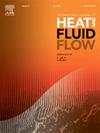Natural convection through and over a heating porous medium: Towards high fidelity simulations of nuclear spent fuel pools
IF 2.6
3区 工程技术
Q2 ENGINEERING, MECHANICAL
International Journal of Heat and Fluid Flow
Pub Date : 2025-01-09
DOI:10.1016/j.ijheatfluidflow.2024.109724
引用次数: 0
Abstract
This paper presents a numerical investigation involving Direct Numerical Simulations (DNS) of natural convection occurring within mixed domains of porous and pure fluids, featuring an internally heated solid matrix. Our study does not aim to replicate 1:1 scale of Spent Fuel Pool (SFP) scenarios during Loss of Cooling Accidents (LOCA), but rather focuses on a reduced scale mock-up of such pool while keeping essential phenomena. By doing such, this study does provide valuable insights into the intricate dynamics of fluid flow and heat transfer in such prototypical configuration. We conduct a sensitivity analysis on the parameters driving the physical modeling of the porous medium, revealing the substantial influence of the drag on key features of the heat and mass transfers such as the Large-Scale Circulation (LSC), mass flow rates, temperatures within the porous medium, and overall heat transfer process. In a domain scaled to represent a reduced-scale SFP (1:200), we explore the effects of varying rack heights relative to the bottom wall. This variation significantly affects temperature distribution within both the bottom layer and the porous medium. Notably, when the racks make contact with the bottom wall, a dual-roll LSC pattern emerges. Additionally, we examine the consequences of non-uniform heat load distribution within the racks. This distribution leads to larger maximum temperatures within the most heated region of the porous medium. However, it also results in lower area-averaged temperatures due to increased horizontal diffusion and mixing. Consequently, the Nusselt number within the pure-fluid region is reduced compared to a scenario with uniform heat load distribution.
求助全文
约1分钟内获得全文
求助全文
来源期刊

International Journal of Heat and Fluid Flow
工程技术-工程:机械
CiteScore
5.00
自引率
7.70%
发文量
131
审稿时长
33 days
期刊介绍:
The International Journal of Heat and Fluid Flow welcomes high-quality original contributions on experimental, computational, and physical aspects of convective heat transfer and fluid dynamics relevant to engineering or the environment, including multiphase and microscale flows.
Papers reporting the application of these disciplines to design and development, with emphasis on new technological fields, are also welcomed. Some of these new fields include microscale electronic and mechanical systems; medical and biological systems; and thermal and flow control in both the internal and external environment.
 求助内容:
求助内容: 应助结果提醒方式:
应助结果提醒方式:


